Related Research Articles
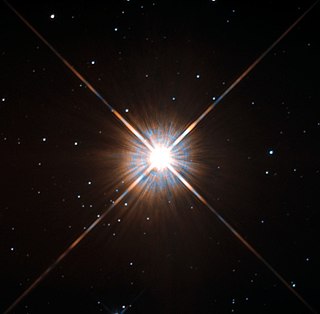
A red dwarf is the smallest and coolest kind of star on the main sequence. Red dwarfs are by far the most common type of star in the Milky Way, at least in the neighborhood of the Sun, but because of their low luminosity, individual red dwarfs cannot be easily observed. From Earth, not one star that fits the stricter definitions of a red dwarf is visible to the naked eye. Proxima Centauri, the nearest star to the Sun, is a red dwarf, as are fifty of the sixty nearest stars. According to some estimates, red dwarfs make up three-quarters of the stars in the Milky Way.

Siding Spring Observatory near Coonabarabran, New South Wales, Australia, part of the Research School of Astronomy & Astrophysics (RSAA) at the Australian National University (ANU), incorporates the Anglo-Australian Telescope along with a collection of other telescopes owned by the Australian National University, the University of New South Wales, and other institutions. The observatory is situated 1,165 metres (3,822 ft) above sea level in the Warrumbungle National Park on Mount Woorat, also known as Siding Spring Mountain. Siding Spring Observatory is owned by the Australian National University (ANU) and is part of the Mount Stromlo and Siding Spring Observatories research school.

WASP or Wide Angle Search for Planets is an international consortium of several academic organisations performing an ultra-wide angle search for exoplanets using transit photometry. The array of robotic telescopes aims to survey the entire sky, simultaneously monitoring many thousands of stars at an apparent visual magnitude from about 7 to 13.
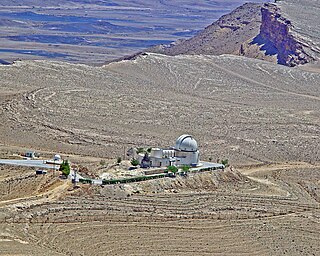
The Florence and George Wise Observatory is an astronomical observatory owned and operated by Tel Aviv University. It is located 5 kilometers west of the town of Mitzpe Ramon in the Negev desert near the edge of the Ramon Crater, and it is the only professional astronomical observatory in Israel.

The Optical Gravitational Lensing Experiment (OGLE) is a Polish astronomical project based at the University of Warsaw that runs a long-term variability sky survey (1992–present). The main goals are the detection and classification of variable stars, discovery of microlensing events, dwarf novae, and studies of the structure of the Galaxy and the Magellanic Clouds. Since the project began in 1992, it has discovered a multitude of extrasolar planets, together with the first planet discovered using the transit method (OGLE-TR-56b) and gravitational microlensing. The project has been led by professor Andrzej Udalski since its inception.

Transiting Exoplanet Survey Satellite is a space telescope for NASA's Explorer program, designed to search for exoplanets using the transit method in an area 400 times larger than that covered by the Kepler mission. It was launched on 18 April 2018, atop a Falcon 9 launch vehicle and was placed into a highly elliptical 13.70-day orbit around the Earth. The first light image from TESS was taken on 7 August 2018, and released publicly on 17 September 2018.

PLAnetary Transits and Oscillations of stars (PLATO) is a space telescope under development by the European Space Agency for launch in 2026. The mission goals are to search for planetary transits across up to one million stars, and to discover and characterize rocky extrasolar planets around yellow dwarf stars, subgiant stars, and red dwarf stars. The emphasis of the mission is on Earth-like planets in the habitable zone around Sun-like stars where water can exist in a liquid state. It is the third medium-class mission in ESA's Cosmic Vision programme and is named after the influential Greek philosopher Plato. A secondary objective of the mission is to study stellar oscillations or seismic activity in stars to measure stellar masses and evolution and enable the precise characterization of the planet host star, including its age.

An exoplanet is a planet located outside the Solar System. The first evidence of an exoplanet was noted as early as 1917, but was not recognized as such until 2016; no planet discovery has yet come from that evidence. What turned out to be the first detection of an exoplanet was published among a list of possible candidates in 1988, though not confirmed until 2003. The first confirmed detection came in 1992, with the discovery of terrestrial-mass planets orbiting the pulsar PSR B1257+12. The first confirmation of an exoplanet orbiting a main-sequence star was made in 1995, when a giant planet was found in a four-day orbit around the nearby star 51 Pegasi. Some exoplanets have been imaged directly by telescopes, but the vast majority have been detected through indirect methods, such as the transit method and the radial-velocity method. As of 1 April 2023, there are 5,346 confirmed exoplanets in 3,943 planetary systems, with 855 systems having more than one planet. This is a list of the most notable discoveries.
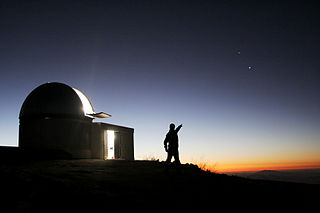
The Transiting Planets and Planetesimals Small Telescope (TRAPPIST) is the corporate name for a pair of Belgian optic robotic telescopes. TRAPPIST–South, which is situated high in the Chilean mountains at ESO's La Silla Observatory, came online in 2010, and TRAPPIST–North situated at the Oukaïmeden Observatory in the Atlas Mountains in Morocco, came online in 2016.
The Kilodegree Extremely Little Telescope is an astronomical observation system formed by two robotic telescopes that are conducting a survey for transiting exoplanets around bright stars. The project is jointly administered by members of Ohio State University Department of Astronomy, the Vanderbilt University Department of Physics and Astronomy Astronomy Group, the Lehigh University Department of Physics, and the South African Astronomical Observatory (SAAO).

The Next-Generation Transit Survey (NGTS) is a ground-based robotic search for exoplanets. The facility is located at Paranal Observatory in the Atacama desert in northern Chile, about 2 km from ESO's Very Large Telescope and 0.5 km from the VISTA Survey Telescope. Science operations began in early 2015. The astronomical survey is managed by a consortium of seven European universities and other academic institutions from Chile, Germany, Switzerland, and the United Kingdom. Prototypes of the array were tested in 2009 and 2010 on La Palma, and from 2012 to 2014 at Geneva Observatory.
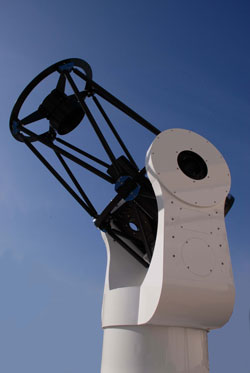
The MINiature Exoplanet Radial Velocity Array (MINERVA) is a ground-based robotic dedicated exoplanet observatory. The facility is an array of small-aperture robotic telescopes outfitted for both photometry and high-resolution Doppler spectroscopy located at the U.S. Fred Lawrence Whipple Observatory at Mt. Hopkins, Arizona. The project's principal investigator is the American astronomer Jason Eastman. The telescopes were manufactured by PlaneWave Instruments.

SPECULOOS (Search for habitable Planets EClipsing ULtra-cOOl Stars) is a project consisting of SPECULOOS Southern Observatory (SSO) at the Paranal Observatory in Chile and SPECULOOS Northern Observatory (SNO) at the Teide Observatory in Tenerife.
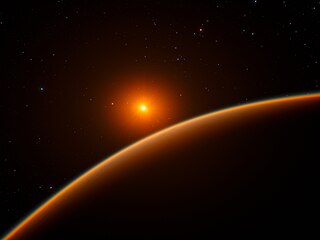
LHS 1140 is a red dwarf in the constellation of Cetus. Based on its stellar properties, it is thought to be about 41 light-years away from the Sun. 'LHS' refers to the Luyten Half-Second Catalogue of stars with proper motions exceeding half a second of arc annually. The star is over 5 billion years old and has only about 18% the mass of the Sun and 21% of its radius. LHS 1140's rotational period is 130 days. No flares have been observed.

LHS 1140 b is a massive, dense rocky planet orbiting within the conservative habitable zone of the red dwarf LHS 1140. Discovered in 2017 by the MEarth Project, LHS 1140 b is nearly 7 times the mass of Earth and over 60% larger in radius, putting it within the Super-Earth category of planets. It is one of the densest planets found, with a density almost twice that of Earth, along with a high surface gravity of about 2.41 Earth's. LHS 1140 b orbits entirely within the star's habitable zone and gets 41% the incident flux of Earth. The planet is only 40 light-years away and transits its star, making it an excellent candidate for atmospheric studies with ground-based and/or space telescopes.

Ross 128 b is a confirmed Earth-sized exoplanet, likely rocky, that is orbiting within the inner habitable zone of the red dwarf Ross 128, at a distance of around 11 light-years from Earth. The exoplanet was found using a decade's worth of radial velocity data using the European Southern Observatory's HARPS spectrograph at the La Silla Observatory in Chile. Ross 128 b is the nearest exoplanet around a quiet red dwarf, and is considered one of the best candidates for habitability. The planet is only 35% more massive than Earth, receives only 38% more starlight, and is expected to be a temperature suitable for liquid water to exist on the surface, if it has an atmosphere.
Luyten b is a confirmed exoplanet, likely rocky, orbiting within the habitable zone of the nearby red dwarf Luyten's Star. It is one of the most Earth-like planets ever found and is the fourth-closest potentially habitable exoplanet known, at a distance of 12 light-years. Only Proxima Centauri b, Ross 128 b, and Gliese 1061 d are closer. Discovered alongside Gliese 273c in June 2017, Luyten b is a Super-Earth of around 2.89 times the mass of Earth and receives only 6% more starlight than Earth, making it one of the best candidates for habitability. In October 2017 and 2018, the nonprofit organization METI sent a message containing dozens of short musical compositions and a scientific "tutorial" towards the planet in hopes of contacting any potential extraterrestrial civilizations.
Gliese 1132 is a small red dwarf star about 41 light-years away from Earth in the constellation Vela. In 2015, it was revealed to have a hot rocky Earth-sized planet orbiting it every 1.6 days, which was later determined to have an atmosphere. In 2018, two more potential planets were revealed.

K2-288Bb is a super-Earth or mini-Neptune exoplanet orbiting in the habitable zone of K2-288B, a low-mass M-dwarf star in a binary star system in the constellation of Taurus about 226 light-years from Earth. It was discovered by citizen scientists while analysing data from the Kepler spacecraft's K2 mission, and was announced on 7 January 2019. K2-288 is the third transiting planet system identified by the Exoplanet Explorers program, after the six planets of K2-138 and the three planets of K2-233.
References
- ↑ "MEarth: looking for transiting, habitable super-Earths around small stars" . Retrieved 2009-12-16.
- ↑ "The MEarth Project: Telescopes".
- ↑ "Welcome to LHS 1140b: A Super-Earth in the Habitable Zone". 20 April 2017.

